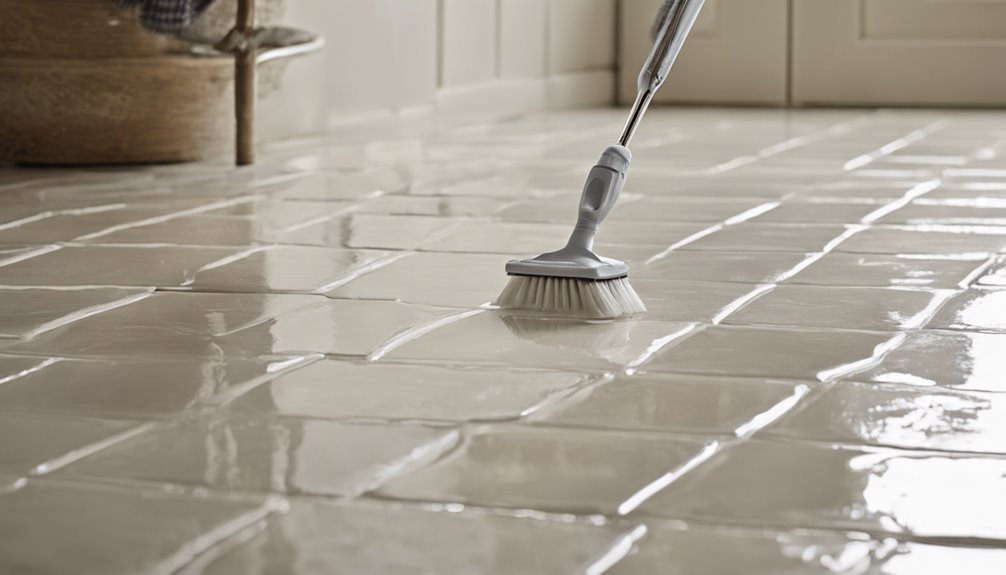To clean floor grout, start by evaluating its condition for stains or mold. Gather supplies like a stiff-bristle brush and a suitable cleaning agent, such as a vinegar solution or baking soda paste. For deep-set stains, consider commercial cleaners or a steam cleaner. Scrub the grout lines carefully, then rinse with hot water to remove residues. After cleaning, make sure the grout dries properly to prevent mold. Finally, seal the grout every 1-2 years to maintain its appearance and longevity. There's more to learn about maintaining grout health and effective cleaning techniques to elevate your floors.
Assessing Your Grout Condition

Before you plunge into cleaning your floor grout, it's important to evaluate its condition to determine the best approach. Start by examining for grout discoloration causes, such as mold, mildew, or stains from spills. Take note of any cracks or erosion, as these issues may require grout repair options before cleaning. For instance, if the grout is crumbling, it might need to be replaced entirely. Conducting a thorough inspection allows you to understand the extent of damage and select appropriate cleaning methods. If you identify deep-set stains, you may need specialized solutions, while lighter discoloration could be remedied with simple cleaning agents. By evaluating your grout's condition, you can guarantee a more effective and lasting cleaning process.
Gathering Necessary Supplies
Before you start cleaning your floor grout, you'll need to gather essential cleaning tools and recommended cleaning solutions. Make certain you have items like a stiff-bristle brush, a bucket, and a mop on hand, as well as effective cleaning agents tailored to your grout's needs. This preparation will guarantee you have everything necessary for a thorough and efficient cleaning process.
Essential Cleaning Tools
Cleaning floor grout effectively requires a specific set of tools that can tackle dirt and stains efficiently. Start by gathering eco-friendly products, which are safe for both your family and the environment. Look for biodegradable cleaners or natural solutions like baking soda and vinegar. Next, invest in grout cleaning gadgets, such as a stiff-bristled brush or a specialized grout scrubber, to penetrate the porous surfaces effectively. A steam cleaner can also be a valuable tool, as it uses high heat to lift grime without harsh chemicals. Don't forget to have microfiber cloths handy for wiping down surfaces post-cleaning. With these essential tools, you'll be well-equipped to restore your grout's original appearance and maintain a healthier living space.
Recommended Cleaning Solutions
Having the right tools is just the start; selecting effective cleaning solutions is equally important for achieving pristine grout. You can choose between store bought cleaners and eco-friendly options, depending on your preferences. For store bought cleaners, look for products specifically designed for grout, as they often contain powerful agents to dissolve stains and mildew. Always follow the manufacturer's instructions for best results. If you prefer eco-friendly options, consider a mixture of baking soda and vinegar. This combination not only cleans effectively but also minimizes harmful chemicals in your home. Whichever route you take, make certain to test a small area first to verify compatibility with your grout. Then, enjoy the satisfaction of beautifully clean floors!
Choosing the Right Cleaning Method

When it comes to tackling grout cleaning, selecting the appropriate method can make all the difference in achieving ideal results. Start by identifying your grout types, as different materials require tailored cleaning methods. Here are some options to contemplate:
- Steam Cleaning: Effective for stubborn stains without chemicals.
- Vinegar Solution: Great for light cleaning on ceramic grout.
- Commercial Cleaners: Designed specifically for tougher grout types.
- Scrubbing: Manual scrubbing with a brush works wonders for deep-set grime.
Evaluate the severity of the grime and the grout's material before deciding. This thoughtful approach guarantees you choose a cleaning method that not only suits your needs but also preserves your flooring's integrity.
DIY Cleaning Solutions
While commercial cleaners can be effective, many people find that DIY cleaning solutions offer a cost-effective and environmentally friendly alternative for tackling grout stains. You can easily create effective mixtures using natural ingredients found in your kitchen. For instance, combining equal parts of baking soda and vinegar creates a powerful paste that can lift grime and stains. Alternatively, a mixture of hydrogen peroxide and baking soda can also work wonders. For those seeking eco-friendly options, lemon juice mixed with baking soda serves as a natural bleach, brightening the grout without harsh chemicals. Apply your chosen solution to the stained grout, let it sit for a few minutes, then wipe it clean for a fresh, revitalized look.
Using a Grout Brush

When it comes to cleaning floor grout effectively, using the right grout brush is essential. You'll want to select a brush that suits the width and depth of your grout lines, and applying proper cleaning techniques will enhance your results. Additionally, incorporating maintenance tips can help keep your grout looking pristine for longer.
Selecting the Right Brush
Choosing the right brush for cleaning grout can make all the difference in achieving a deep clean. When selecting a grout brush, consider the various grout brush types available and the brush bristle materials. Different brushes serve specific purposes, so knowing your options helps.
- Stiff bristle brushes: Ideal for tough stains and grime.
- Soft bristle brushes: Perfect for delicate tiles, preventing damage.
- Angled brushes: Great for reaching corners and tight spaces.
- Electric scrubbers: Save time and effort, especially on large areas.
Proper Cleaning Technique
To achieve ideal results when cleaning floor grout, start by applying a suitable cleaning solution directly onto the grout lines. Allow it to sit for a few minutes to break down dirt and stains. Then, using your grout brush, work the solution into the grout with firm, circular motions. This method effectively removes grout discoloration and restores its original color.
| Cleaning Technique | Recommended Frequency |
|---|---|
| Daily light cleaning | As needed |
| Deep cleaning | Monthly |
| Stain removal | Immediately |
| High-traffic areas | Weekly |
| Post-renovation cleanup | Once after completion |
Regular cleaning frequency can prevent severe discoloration, making your grout look fresh and vibrant.
Maintenance Tips for Grout
While maintaining clean grout may seem challenging, using a grout brush can simplify the process considerably. By incorporating this tool into your routine, you can effectively combat grout discoloration causes such as dirt, mold, and spills. Aim for a grout maintenance frequency that suits your lifestyle; typically, once a month should suffice.
Here are some tips to enhance your grout maintenance:
- Choose a high-quality grout brush for effective scrubbing.
- Use a mild cleaning solution to avoid damaging the grout.
- Focus on small sections to guarantee thorough cleaning.
- Rinse well after scrubbing to remove any residue.
Applying Stain Removers
Applying stain removers effectively can make a significant difference in the appearance of your floor grout. First, identify the stain types—whether they're from food, mold, or grease—as this determines the remover you'll need. For organic stains, a vinegar and water solution may suffice, while tougher stains might require a commercial grout cleaner.
When applying, use a toothbrush or a soft-bristle brush for precise application techniques that allow you to target stains without damaging the grout. Apply the stain remover generously, letting it sit for the recommended time to penetrate the stain. Rinse thoroughly with water afterward. Remember, consistency is key; repeat the process as necessary until your grout is clean and restored to its original beauty.
Sealing Your Grout

Once your grout is clean and free of stains, the next step is sealing it to protect against future discoloration and damage. Different grout types require specific sealing methods, so make sure you choose the right one for your floor.
Here are some sealing options to evaluate:
- Penetrating Sealers: Ideal for porous grout, they soak in and provide strong protection.
- Membrane Sealers: Form a barrier on the surface, great for glossy finishes.
- Color-enhancing Sealers: Boost the color of your grout while sealing it.
- Water-based Sealers: Eco-friendly options that are easy to apply.
Maintaining Clean Grout
Regularly maintaining clean grout is essential for prolonging its lifespan and appearance. By implementing a few simple grout maintenance tips, you can guarantee your floors look fresh for years to come. Here's a quick reference table for effective long-term care:
| Task | Frequency |
|---|---|
| Sweep/Vacuum | Daily |
| Deep Clean | Monthly |
| Reseal Grout | Every 1-2 years |
| Inspect | Every 6 months |
Utilizing these strategies not only helps in maintaining cleanliness but also prevents the buildup of mold and mildew. Remember, consistent care today saves you from costly repairs later. With a little effort, you can enjoy the freedom of beautiful, hassle-free floors!
Frequently Asked Questions
How Often Should I Clean My Floor Grout?
You should aim for a regular cleaning frequency to maintain your grout effectively. Ideally, clean your grout every month, especially in high-traffic areas. For light use, every three months might suffice. Consistent grout maintenance prevents dirt build-up and staining, making your cleaning efforts easier. Remember, a little attention now can save you from intensive scrubbing later. So, keep an eye on your grout and stick to a routine that works for you!
Can I Use a Steam Cleaner on Grout?
Yes, you can use a steam cleaner on grout, and it comes with several benefits. Steam cleaning efficiently lifts dirt and grime without harsh chemicals, making it a great option for those seeking a more natural approach. When employing grout cleaning techniques, verify you follow the manufacturer's instructions for your steam cleaner. This method not only sanitizes but also restores the grout's original color, giving your floors a fresh, clean appearance.
What Types of Grout Are Most Difficult to Clean?
When considering the types of grout that can be tough to clean, epoxy grout often tops the list. For instance, if you've installed it in a busy kitchen, you might find it challenging to remove stains due to its dense, non-porous nature. Sanded grout, while more common, can also pose problems, especially in high-traffic areas where dirt and grime settle into its texture. Both require specific techniques for effective cleaning, so you'll want to be prepared.
Is It Safe to Use Bleach on Grout?
Using bleach on grout can be risky. While it may effectively disinfect, it often leads to grout discoloration over time, especially if the grout is colored. You might want to evaluate bleach alternatives like vinegar or hydrogen peroxide, which are gentler and less likely to cause fading. Always test any cleaner on a small area first to verify it won't damage your grout or alter its appearance before proceeding with a full application.
How Do I Know if My Grout Needs Sealing?
To determine if your grout needs sealing, look for discoloration, stains, or water absorption. If water beads on the surface, your grout's likely sealed. However, if it soaks in quickly, it may require grout sealing. Regular grout maintenance is essential to prevent mold and damage. Performing a simple water test can help you assess its condition. If you notice any issues, consider sealing it to protect your floors effectively.




